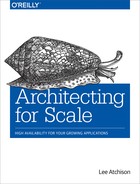Foreword
We are living in interesting times, a software Cambrian explosion if you will, where the cost of building new systems has fallen by orders of magnitude and the connectivity of systems has grown by equal orders of magnitude. Resources like Amazon’s AWS, Microsoft’s Azure, and Google’s GCP make it possible for us to physically scale our systems to sizes that we could only have imagined a few years ago.
The economics of these resources and seemingly limitless capacity is producing a uniquely rapid radiation of new ideas, new products, and new markets in ways that were never possible before. But all of these new explorations are only possible if the systems we build can scale. While it is easier than ever to build something small, building a system that can scale quickly and reliably proves to be a lot harder than just spinning up more hardware and more storage.
Software systems go through a predictable lifecycle starting with small well-crafted solutions fully understood by a single person, through the rapid growth into a monolith of technical debt, thence fissioning into an ad hoc collection of fragile services, and finally into a well-engineered distributed system able to scale reliably in both breadth (more users) and depth (more features). It’s easy to see what needs to be done from the outside (make it more reliable!) and much harder to see the path from the inside. Fortunately, this book is the essential guidebook for the journey—from availability to service tiers, from game days to risk matrices, Lee describes the key decisions and practices for systems that scale.
Lee joined me at New Relic when we were first moving from being a single product monolith into being a multiproduct company, all while enjoying the hyper-growth in satisfied customers that made New Relic so successful. Lee came with a lot of experience at Amazon, both on the retail side where they grew a lot and on the AWS side where—guess what?—they grew a lot. Lee has been part of teams and led teams and been actively involved in a whole lot of scaling and he has the scars to prove it. Fortunately for us, he’s lived through the mistakes and suffered through fiendishly difficult outages and is now passing along those lessons so that we don’t have to get those same scars.
When Lee joined New Relic, we were suffering through our awkward teenage fail whale years. Our primitive monolith was suffering from our success and our availability, reliability, and performance was not good. By putting in place the techniques he’s written about in this book, we graduated from those high school years and built the robust enterprise-level service that exists today. One of our tools was establishing four levels of availability engineering: Bronze, Silver, Gold, and Platinum. To earn the Bronze level, a team had to have a risk matrix, have defined SLAs. To earn the Silver level, a team had to be monitoring for the problems identified in the matrix and be using game days; Gold meant that the risks were mitigated; and Platinum was like a CMM Level 5 where the systems were self-healing and the focus was on continuous improvement. We prioritized these efforts for the Tier 1 services first, then the Tier 2 services, etc and we eventually got everyone to at least Silver and most of the teams through Gold (and a couple to Platinum).
When I moved to InVision App, I joined a younger company, again moving through the transition from early success to hyper growth, and thus I’m driving forward all these same techniques and tools that Lee describes. I urge you, in your journey as part of this exciting explosion of new systems and products and companies, to do the same: to learn from Lee in building your systems for scale.
